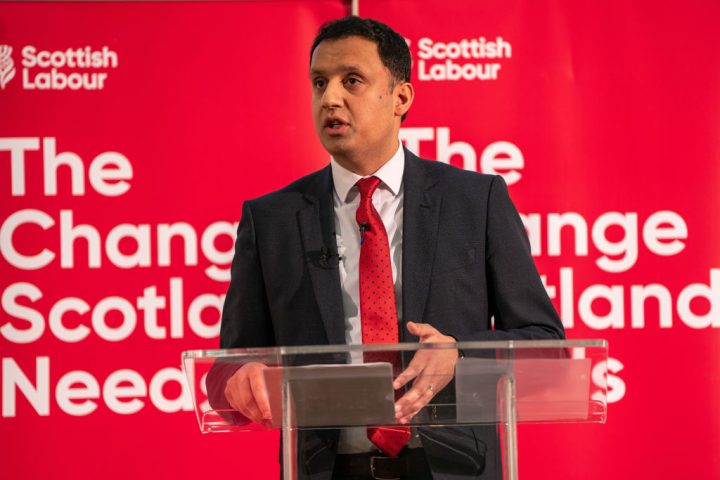Scottish Labour gathers in Glasgow this weekend in both a mental and electoral state few thought achievable just a short few years ago. Having polled less than 10 per cent in the (albeit meaningless) European Parliament elections of 2019, followed by another humiliating third placed finish at the Holyrood elections of 2021 with less than 18 per cent of the regional vote, Labour looked helpless and hopeless.
But things change. Quickly. Lenin said that there are decades where nothing happens, and there are weeks where decades happen. Scottish Labour’s ascent is not quite in that category, but nevertheless Anas Sarwar’s outfit has rapidly morphed from the irrelevant cousin-at-the-wedding to the bride-to-be.
Sarwar needs to offer soft nationalists a credible future direction of travel on the constitution
Scottish Labour lack breadth, but they have a decent amount of depth. Jackie Baillie (shadow health minister) and Pam Duncan-Glancy (shadow education minister) appear prepared to think the hitherto unthinkable in some areas of public service provision – albeit not to the degree that reformers like me may wish. Daniel Johnson (Scottish Labour’s economy spokesperson) and Michael Marra (shadow finance minister) have genuine competence on the economy and are committed capitalists – an obvious statement to many readers, but one which has been in question under the tutelage of the Green/SNP coalition. And Rhoda Grant (rural affairs spokesperson) and Sarah Boyack (shadow environment secretary) are feeling their way through the chasm between rural and urban Scotland, and the key role that renewable energy will play in bridging it.
But here we must hold our horses. Because unlike his counterpart in London, Sir Keir Starmer, Sarwar remains far from power. While Starmer can, if the polls are even vaguely correct, start measuring the curtains in 10 Downing Street, the keys to 5 Charlotte Square, the address of Bute House and the official residence of Scotland’s First Minister, remain much further out of Sarwar’s grasp.
Labour has topped precisely zero constituency vote polls during this parliament, and only two of the last five regional list polls. One has to turn the clock back nearly a year to find them polling to win the most seats at Holyrood (it has happened only once) and nearly six months to find them level.
Scottish Labour is not UK Labour. Despite dismal school outcomes and economic stagnation, ferry fiascos and gender recognition, Covid inquiries and police investigations, Scottish Labour is not winning. The SNP is winning. Sarwar and his colleagues should be reminding themselves of that every day, and be asking themselves why.
The answer is not all that hard to find. In order to win, Scottish Labour needs to convert two target audiences. One – those soft unionists who have spent the last few elections voting for the Conservatives – is largely already in the bag. Those voters are focussed on preventing a second independence referendum and, although not ideological Conservatives, have in recent years seen the Tories as the best bet to deliver that outcome.
They do not anymore: they can see Sir Keir in Downing Street, they are comfortable in the knowledge that a second independence referendum is all but off the table and they have ended their uncomfortable marriage-of-convenience with the Tories. As such they have relegated that party to its core vote in the teens and boosted Labour.
But while that job is largely done, the same cannot be said of Labour’s second audience: the soft nationalists. These are people who have been voting SNP for well over a decade now. They remain in favour of independence, with ‘Yes’ polling still strong. But they are not unreconstructable anti-Brits and have, in addition, become disillusioned with the SNP’s performance in government, particularly since 2021.
However, speak privately to SNP politicians doing the rounds on the doorsteps of their constituencies and they will give you a fairly straight take on the intentions of these disillusioned voters. They have left the SNP, but they are more likely to stay at home, or to be undecided, than they are to move to Labour.
Persuading the people that he can form a competent government which can simply be better at running the place than the Nats will help deliver Sarwar a victory in the 2026 Scottish parliament election. A victory for Sir Keir, and the momentum that will most likely trigger in Scotland will also help deliver Sarwar that victory. (Indeed, were Starmer to fail, such would be the boost to the SNP’s narrative that only independence can stop the Tories, that Sarwar would surely be destined for the same outcome).
But neither of these are enough to deliver that victory. To finish the job, Sarwar needs to offer these soft nationalists a credible future direction of travel on the constitution. He needs to set out what the UK will look like under Labour, in order to once again make ‘No’ more attractive than ‘Yes’. As tough a sell as it is at the moment, and as battle-scarred as some Labour supporters are from the decade-long constitutional battle, that will involve some carefully planned decentralisation of power from Westminster to Holyrood.
But, perhaps more than that, Labour’s big sell to soft nationalists could be the regionalisation of Scotland, which has become increasingly centralised and homogenised under the SNP. Stripping Holyrood of a range of powers and passing them to local authorities, and to larger regional units, could provide both a distinctive selling point and a genuine legacy. Such a policy could deliver votes in the short term, and change the country for the better in the long term. That is, after all, what all of this is supposed to be about.






Comments